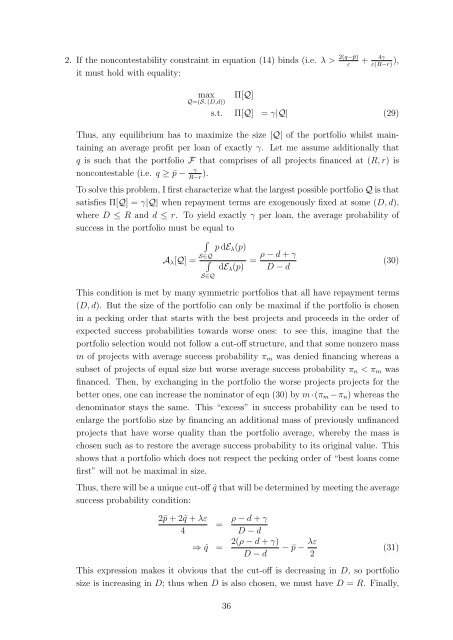Bank Competition, Information Choice and Inefficient Lending Booms
Bank Competition, Information Choice and Inefficient Lending Booms
Bank Competition, Information Choice and Inefficient Lending Booms
Create successful ePaper yourself
Turn your PDF publications into a flip-book with our unique Google optimized e-Paper software.
2. If the noncontestability constraint in equation (14) binds (i.e. λ > 2(q−¯p)<br />
ε<br />
+ 4γ<br />
ε(R−r) ),<br />
it must hold with equality:<br />
max<br />
Q=(S, (D,d))<br />
Π[Q]<br />
s.t. Π[Q] = γ|Q| (29)<br />
Thus, any equilibrium has to maximize the size |Q| of the portfolio whilst maintaining<br />
an average profit per loan of exactly γ. Let me assume additionally that<br />
q is such that the portfolio F that comprises of all projects financed at (R, r) is<br />
noncontestable (i.e. q ≥ ¯p −<br />
γ<br />
R−r ).<br />
To solve this problem, I first characterize what the largest possible portfolio Q is that<br />
satisfies Π[Q] = γ|Q| when repayment terms are exogenously fixed at some (D, d),<br />
where D ≤ R <strong>and</strong> d ≤ r. To yield exactly γ per loan, the average probability of<br />
success in the portfolio must be equal to<br />
∫<br />
A λ [Q] =<br />
S∈Q<br />
∫<br />
S∈Q<br />
p dE λ (p)<br />
dE λ (p) = ρ − d + γ<br />
D − d<br />
This condition is met by many symmetric portfolios that all have repayment terms<br />
(D, d). But the size of the portfolio can only be maximal if the portfolio is chosen<br />
in a pecking order that starts with the best projects <strong>and</strong> proceeds in the order of<br />
expected success probabilities towards worse ones: to see this, imagine that the<br />
portfolio selection would not follow a cut-off structure, <strong>and</strong> that some nonzero mass<br />
m of projects with average success probability π m was denied financing whereas a<br />
subset of projects of equal size but worse average success probability π n < π m was<br />
financed. Then, by exchanging in the portfolio the worse projects projects for the<br />
better ones, one can increase the nominator of eqn (30) by m·(π m −π n ) whereas the<br />
denominator stays the same. This “excess” in success probability can be used to<br />
enlarge the portfolio size by financing an additional mass of previously unfinanced<br />
projects that have worse quality than the portfolio average, whereby the mass is<br />
chosen such as to restore the average success probability to its original value. This<br />
shows that a portfolio which does not respect the pecking order of “best loans come<br />
first” will not be maximal in size.<br />
Thus, there will be a unique cut-off ˆq that will be determined by meeting the average<br />
success probability condition:<br />
2¯p + 2ˆq + λε<br />
= ρ − d + γ<br />
4<br />
D − d<br />
2(ρ − d + γ)<br />
⇒ ˆq =<br />
D − d<br />
− ¯p − λε<br />
2<br />
This expression makes it obvious that the cut-off is decreasing in D, so portfolio<br />
size is increasing in D; thus when D is also chosen, we must have D = R. Finally,<br />
36<br />
(30)<br />
(31)
















